March 18 update on COVID-19 in MN: Vaccination pace slips; active cases tick up

Go Deeper.
Create an account or log in to save stories.
Like this?
Thanks for liking this story! We have added it to a list of your favorite stories.
3 things to know
More than 23 percent of Minnesotans with at least one vaccine dose; officials expect big jump soon in supply of one-shot Johnson & Johnson vaccine
Uptick in active cases, hospitalizations; Carver Co. outbreak concerns continue
2 milestones passed: More than 500,000 pandemic cases, more than 2 million vaccine doses in arms
Updated: 4:10 p.m.
It’s clear Minnesota’s in a race now to vaccinate people quickly enough to avoid another statewide COVID-19 surge. Case counts and hospitalizations are starting to rise again slowly, but the overall vaccination pace continues to struggle for traction.
The Health Department on Thursday reported about 36,000 more vaccinations. The seven-day trend is now running just under 40,000 shots daily, roughly what it’s been for the past two weeks.
The flat-to-declining pace isn’t necessarily a problem as Minnesota expects to see federal vaccine shipments jump soon. State officials, though, are increasingly anxious about the growth in cases tied to the highly contagious U.K. COVID-19 variant and to youth sports.
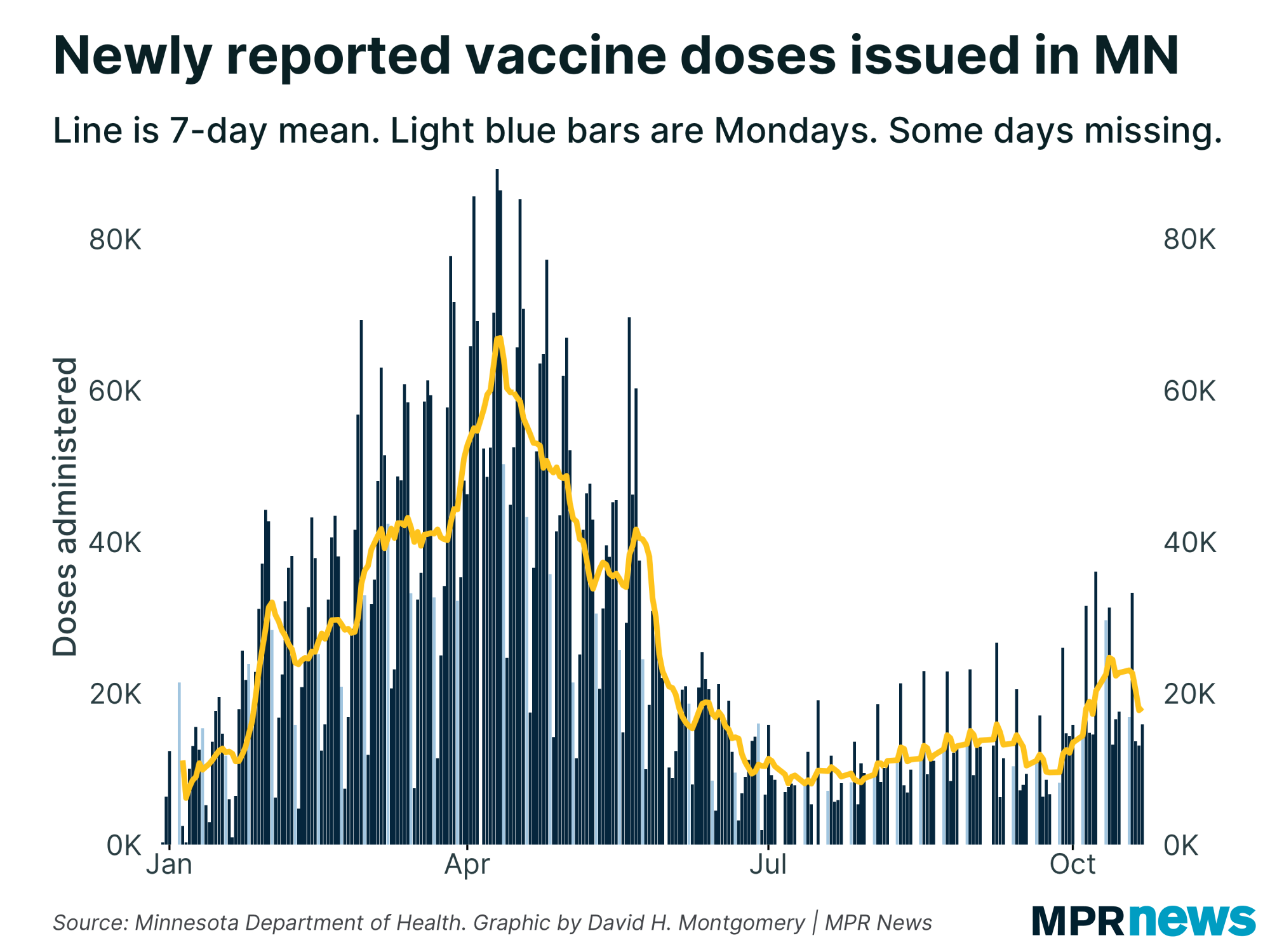
More than 764,000 people — nearly 14 percent of the state’s population — have completed their vaccinations, while more than 1.3 million — 23.4 percent — have received at least one dose, including more than 77 percent of people age 65 and older.
Turn Up Your Support
MPR News helps you turn down the noise and build shared understanding. Turn up your support for this public resource and keep trusted journalism accessible to all.
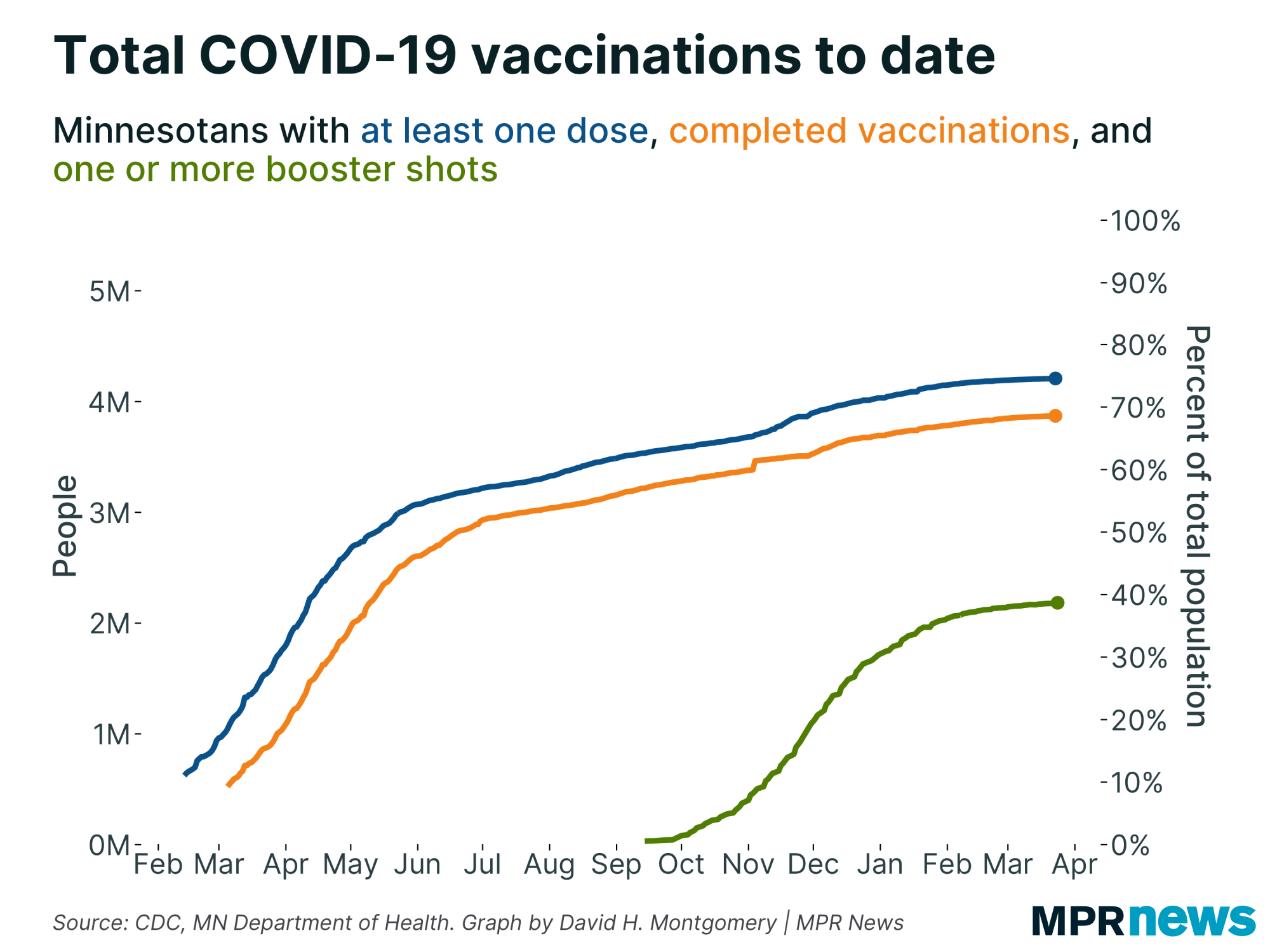
State officials offered some upbeat news Wednesday on the vaccine front: Minnesota may start receiving 100,000 doses a week of the J&J vaccine in April. Because it requires only one dose, it could speed the pace of vaccinations. The state received about 45,000 doses in early March but relatively little since then.
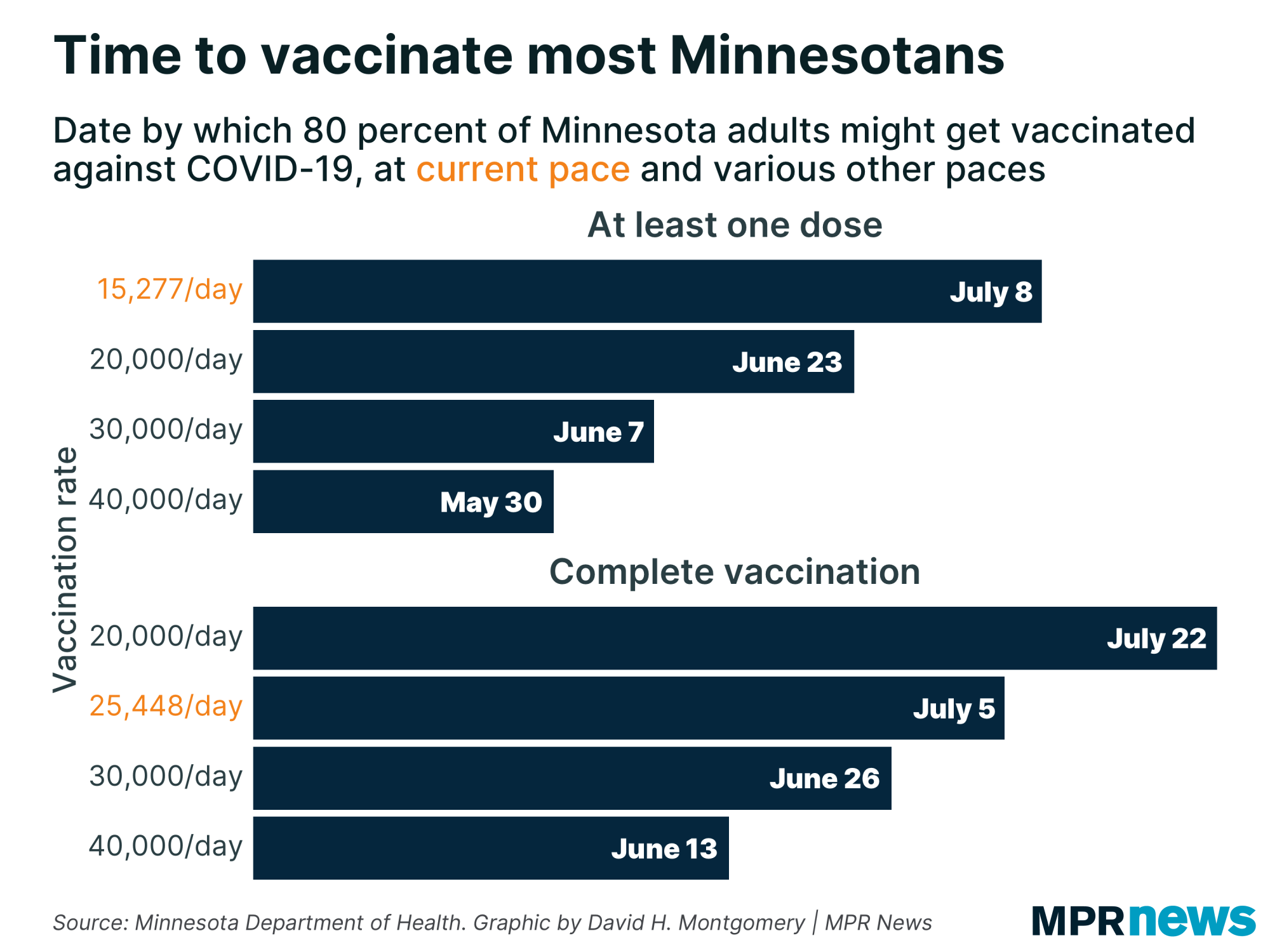
Officials continue to urge Minnesotans to stay vigilant against the disease, wearing masks in public gathering spaces and socially distancing.
Minnesota on Thursday also passed two milestones in the pandemic: Cases have topped 500,000 and there are now more than 2 million shots in arms.
Active cases up; Carver Co., Iron Range hot spots
Minnesota’s COVID-19 numbers show disease conditions relatively stable compared to the late fall surge, but there are some caution lights flashing.
There has been a noticeable rise recently in the number of known, active cases. Thursday’s data shows 9,338 cases, marking seven consecutive days with active counts above 8,000, a stretch not seen since late January.

While current counts are still very low compared to late November and early December, the increase is notable given the concerns about the rise of the U.K. COVID-19 strain in Minnesota.
Hospitalization rates remain mostly at levels last seen before the late-fall surge in cases, but there has been a noticeable uptick: 297 people were hospitalized as of Wednesday, with 74 needing intensive care. The number of ICU patients has doubled since March 6.
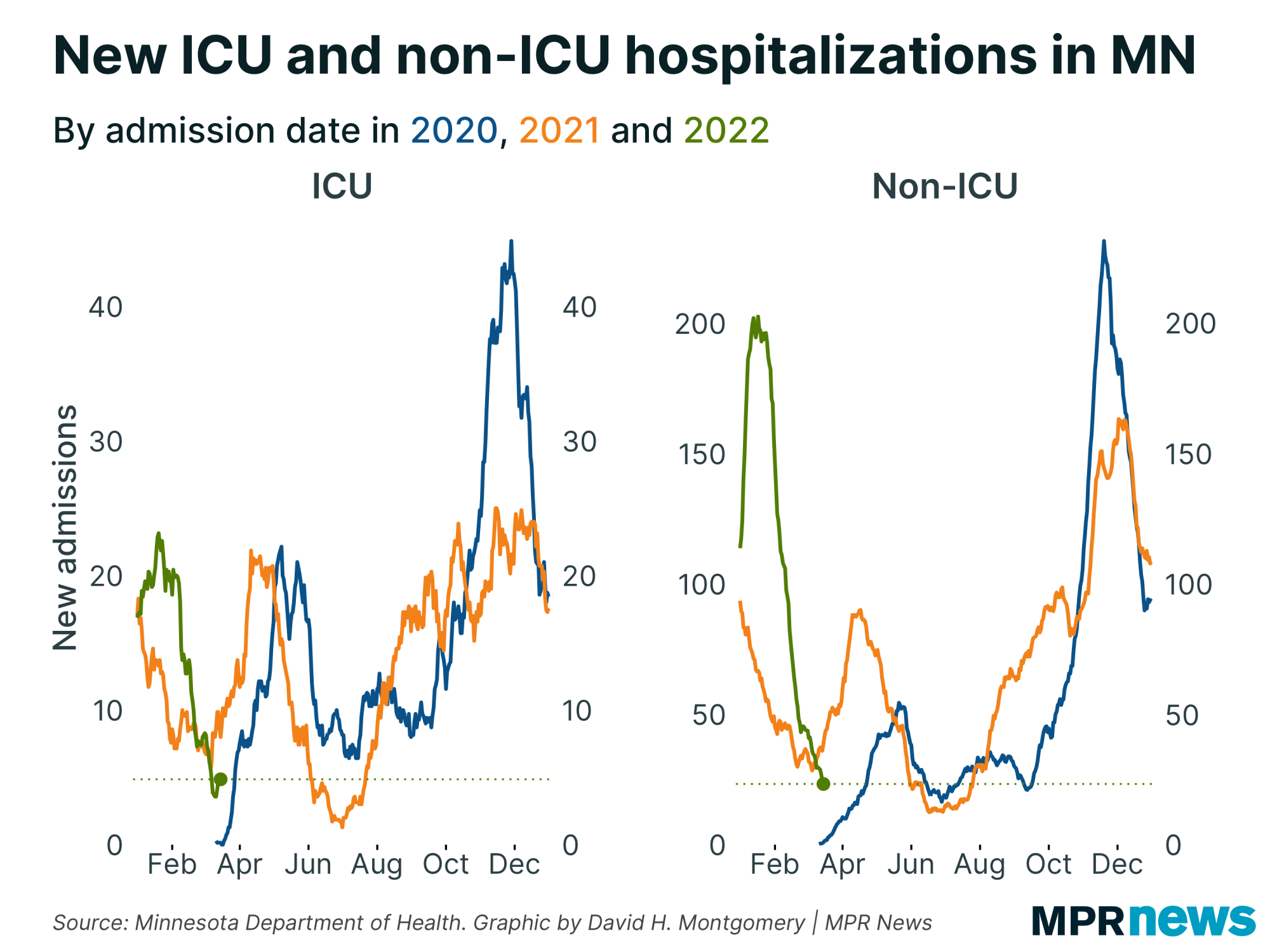
Six newly reported deaths brought Minnesota’s collective pandemic death toll to 6,762. Among those who’ve died, about 63 percent had been living in long-term care or assisted living facilities; most had underlying health problems.

The state has recorded 501,458 total confirmed or probable cases so far in the pandemic, including 1,505 posted Thursday. About 97 percent of Minnesotans known to be infected with COVID-19 in the pandemic have recovered to the point where they no longer need to be isolated.

State public health leaders continue to keep close watch on a Carver County outbreak that includes the very contagious U.K. strain. Twelve people have been hospitalized statewide from that strain; two have died.
“We are very concerned about this (U.K.) variant and its rapid spread. It has the potential to be a setback to our continued and hard-fought progress against the disease,” Dan Huff, an assistant health commissioner, told reporters Monday.
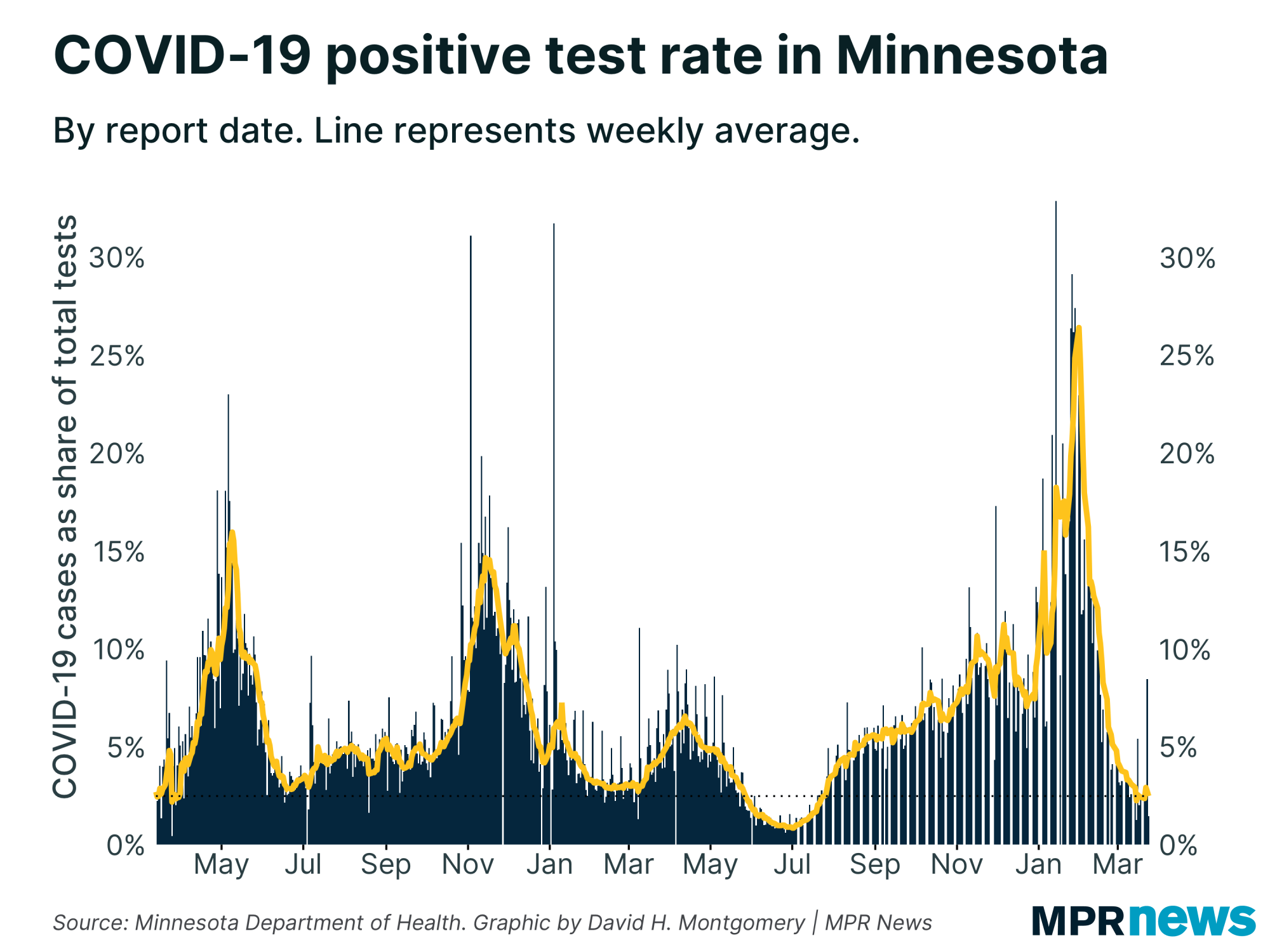
With more than 250 cases of the U.K. variant confirmed statewide, it has the potential to spread throughout the state unless checked, Huff said. “We’re so close to the light at the end of the tunnel …. but this thing’s not over.”
The state is recommending young people across the state be tested every two weeks for COVID-19, with student athletes tested weekly; officials are also asking everyone in Carver County to get tested.
The Health Department on Thursday also warned of a COVID-19 outbreak in the eastern end of Minnesota’s Iron Range centered around the town of Aurora.
Officials did not specify how many cases they’re seeing but said they would open a free testing site in Aurora on Monday and Tuesday and encouraged anyone in the area to get tested.
“We are increasingly concerned about dramatic increases in cases, particularly in St. Louis County. Right now Aurora is at the heart of this COVID-19 hot spot, which is spreading to neighboring counties,” the Health Department said in a statement Thursday.
Cases spread across age groups, regions
People in their 20s still make up the age bracket with the state’s largest number of confirmed cases — nearly 94,000 since the pandemic began, including more than 49,000 among those ages 20 to 24.

The number of high school-age youth confirmed with the disease has also grown, with nearly 40,000 total cases among those ages 15 to 19 since the pandemic began.
With kids increasingly returning to school buildings and sports, Minnesota public health officials are urging Minnesota families with children to get tested every two weeks for COVID-19 now until the end of the school year.
Although young people are less likely to feel the worst effects of the disease and end up hospitalized, experts worry youth will spread it unknowingly to older relatives and members of other vulnerable populations.
People can have the coronavirus and spread COVID-19 when they don’t have symptoms.
Regionally, all parts of Minnesota are in significantly better shape than they were in late November and early December. Some areas are seeing upticks in cases.

While officials monitor the recent uptick in active cases, overall trends have improved to the point where Gov. Tim Walz last week announced a rollback of many of the state’s remaining pandemic restrictions. “Normalcy is on the horizon,” the governor said.
But it’s not quite there yet. On Wednesday, Walz said that he, Lt. Gov. Peggy Flanagan and Health Commissioner Jan Malcolm were quarantining because of possible COVID-19 exposure. Walz was tested Thursday for COVID-19, and the result came back negative, his spokesperson said.
Caseloads among people of color
In Minnesota and across the country, COVID-19 has hit communities of color disproportionately hard in both cases and deaths. That’s been especially true for Minnesotans of Hispanic descent for much of the pandemic.

Even as new case counts continue to track well below their late November, early December peaks, the data shows Latino people continue to be hit hard.
Distrust of the government, together with deeply rooted health and economic disparities, have hampered efforts to boost testing among communities of color, officials say, especially among unauthorized immigrants who fear their personal information may be used to deport them.
Walz has acknowledged that distrust by communities of color has been a problem during the pandemic. Officials have offered up some data on vaccinations broken down by race and ethnicity. The state is updating the data weekly.
Malcolm has said the state is committed to doing more to expand vaccine access to people of color, including getting more doses to community pharmacies, partnering with local groups and deploying mobile vaccination clinics.
Long-term care visiting rules loosened
New guidance will allow for more visits and social activities at Minnesota long-term care facilities.
Facilities should be allowed indoor visitations at all times and for all residents regardless of whether they are vaccinated, except for a few circumstances when visitations should be limited due to the high risk of spreading COVID-19.
Residents will no longer be required to isolate after visits as long as they follow other safety protocols and risk levels in individual facilities remain low.
Inside those settings, communal dining will be more common with proper social distancing along with other group activities such as bingo.
The Health Department updated the guidance Wednesday. It now follows federal Centers for Disease Control and prevention advice for places where case counts are dropping and vaccinations are increasing.
COVID-19 in Minnesota
Data in these graphs are based on the Minnesota Department of Health's cumulative totals released at 11 a.m. daily. You can find more detailed statistics on COVID-19 at the Health Department website.
Top headlines
Walz, Flanagan to quarantine after possible COVID exposure: The governor’s office says he tested negative on Monday but that he, Lt. Gov. Peggy Flanagan and Minnesota Health Commissioner Jan Malcolm will quarantine through March 25 given the possible exposure.
Eligible for COVID-19 vaccines, food plant workers have mixed feelings about them: Almost a year after COVID-19 surged through Minnesota’s food processing workforce, plant employees are now on the priority list for vaccination. One group is trying to find out why people may hesitate.
As gaps emerge, Minnesota hires head of vaccine equity: The Health Department’s new head of vaccine equity is looking to other states for ideas to help vulnerable communities get to the front of the vaccine line. That could include special vaccine allotments and sign-up periods for people who have struggled to get vaccinated.


